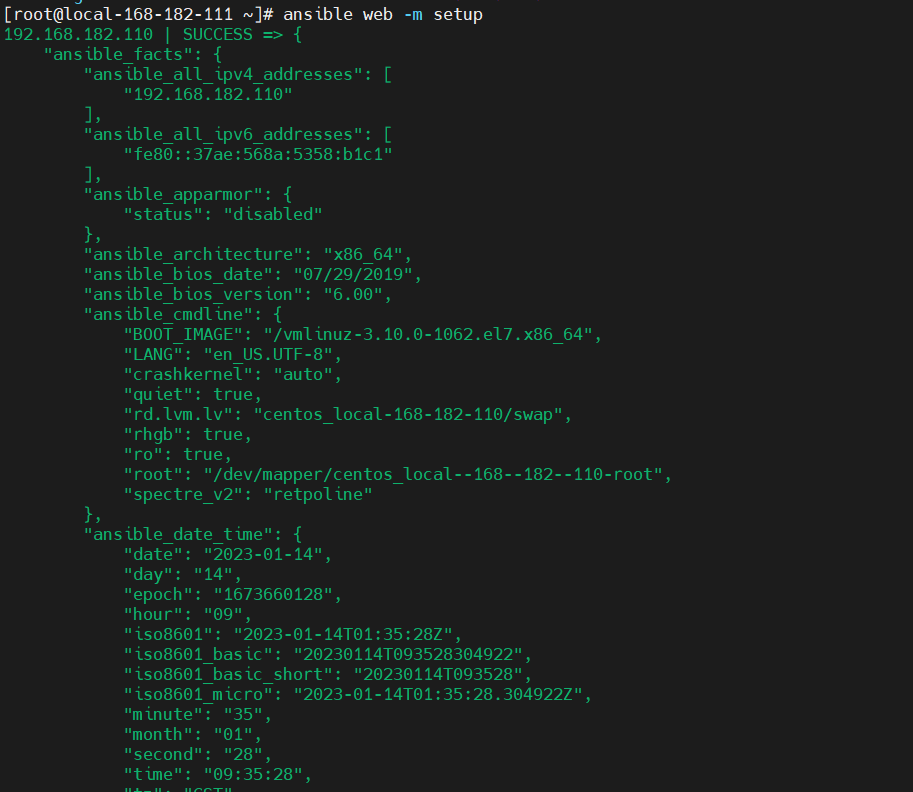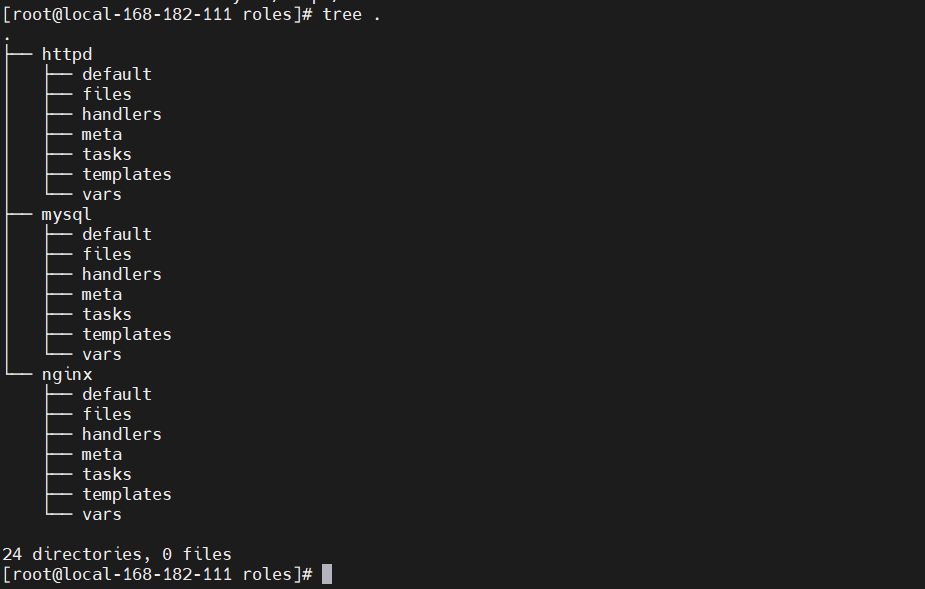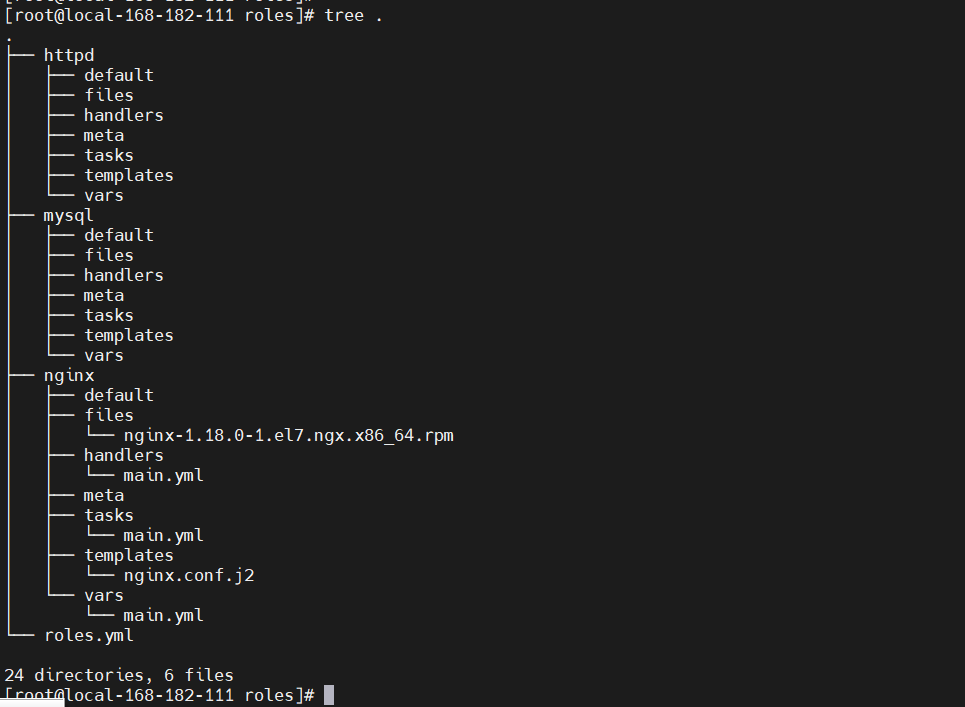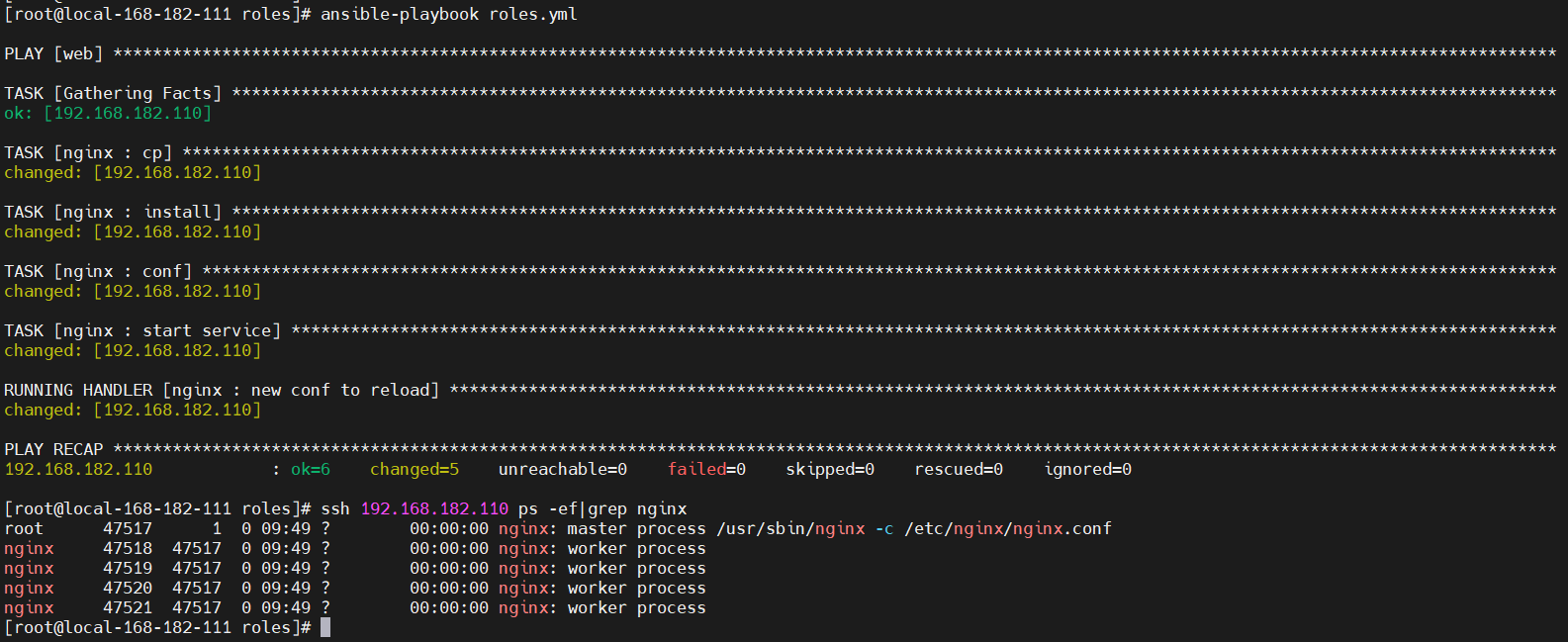Ansible Playbook 講解與實戰操作
一、概述
- playbook與ad-hoc比較,是一種完全不同的運用ansible的方式,類似與saltstack的state狀態檔。 ad-hoc無法持久使用,playbook可以持久使用。
- playbook是由一個或多個play組成的列表,play的主要功能在於將事先歸併為一組的主機裝扮成事先通過ansible中的task定義好的角色。
- 從根本上來講,所謂的task無非是呼叫ansible的一個module。將多個play組織在一個playbook中,即可以讓它們聯合起來按事先編排的機製完成某一任務。
參考文件:https://ansible-tran.readthedocs.io/en/latest/docs/playbooks.html
Ansible 的基礎介紹和環境部署可以參考我這篇文章:#Ansible 介紹與實戰操作演示

#二、playbook 核心元素
- ##Hosts執行的遠端主機清單
- Tasks任務集
- Varniables內建變數或自訂變數在playbook中呼叫
- Templates模板,即使用模板語法的文件,例如設定檔等
- Handlers 和notity結合使用,由特定條件觸發的操作,滿足條件方才執行,否則不執行
- Tags標籤,指定某條任務執行,用於選擇運行playbook中的部分程式碼。
- #playbook使用yaml語法格式,後綴可以是yaml,也可以是yml。
- YAML( /ˈjæməl/ )參考了其他多種語言,包括:XML、C語言、Python、Perl以及電子郵件格式RFC2822,Clark Evans在2001年5月在首次發表了這種語言,另外Ingy döt Net與OrenBen-Kiki也是這語言的共同設計者。
- YAML格式是類似JSON的檔案格式。 YAML用於檔案的設定編寫,JSON多用於開發設計。
- 檔案的第一行應該以「--- 」(三個連字符)開始,表示YAML檔案的開始。
- 在同一行中,#之後的內容表示註釋,類似於shell,python和ruby。
- YAML中的清單元素以「-」開頭並且跟著一個空格。後面為元素內容。
- 同一個清單之中的元素應該保持相同的縮進,否則會被當作錯誤處理。
- play中hosts、variables、roles、tasks等物件的表示方法都是以鍵值中間以「:」分隔表示,並且「:」之後要加一個空格。
Hosts:运行指定任务的目标主机
remoute_user:在远程主机上执行任务的用户;
sudo_user:
tasks:任务列表
tasks的具体格式:
tasks:
- name: TASK_NAME
module: arguments
notify: HANDLER_NAME
handlers:
- name: HANDLER_NAME
module: arguments
##模块,模块参数:
格式如下:
(1)action: module arguments
(2) module: arguments
注意:shell和command模块后直接加命令,而不是key=value类的参数列表
handlers:任务,在特定条件下触发;接受到其他任务的通知时被触发;
登入後複製
#3、範例Hosts:运行指定任务的目标主机 remoute_user:在远程主机上执行任务的用户; sudo_user: tasks:任务列表 tasks的具体格式: tasks: - name: TASK_NAME module: arguments notify: HANDLER_NAME handlers: - name: HANDLER_NAME module: arguments ##模块,模块参数: 格式如下: (1)action: module arguments (2) module: arguments 注意:shell和command模块后直接加命令,而不是key=value类的参数列表 handlers:任务,在特定条件下触发;接受到其他任务的通知时被触发;
---
- hosts: web
remote_user: root
tasks:
- name: install nginx##安装模块,需要在被控主机里加上nginx的源
yum: name=nginx state=present
- name: copy nginx.conf##复制nginx的配置文件过去,需要在本机的/tmp目录下编辑nginx.conf
copy: src=/tmp/nginx.conf dest=/etc/nginx/nginx.conf backup=yes
notify: reload#当nginx.conf发生改变时,通知给相应的handlers
tags: reloadnginx#打标签
- name: start nginx service#服务启动模块
service: name=nginx state=started
tags: startnginx#打标签
handlers:
- name: reload
service: name=nginx state=restarted
登入後複製
2)variables 變數--- - hosts: web remote_user: root tasks: - name: install nginx##安装模块,需要在被控主机里加上nginx的源 yum: name=nginx state=present - name: copy nginx.conf##复制nginx的配置文件过去,需要在本机的/tmp目录下编辑nginx.conf copy: src=/tmp/nginx.conf dest=/etc/nginx/nginx.conf backup=yes notify: reload#当nginx.conf发生改变时,通知给相应的handlers tags: reloadnginx#打标签 - name: start nginx service#服务启动模块 service: name=nginx state=started tags: startnginx#打标签 handlers: - name: reload service: name=nginx state=restarted
#variables變數有四種定義方法。如下:
1、facts:可以直接呼叫ansible中有setup模組,這個模組就是透過facts元件來實現的,主要是節點本身的一個系統訊息,bios資訊,網絡,硬碟等等資訊。這裡的variables也可以直接呼叫facts元件的facters我們可以使用setup模組來獲取,然後直接放入我們的劇本之中呼叫即可。
ansible web -m setup

常用的几个参数:
ansible_all_ipv4_addresses # ipv4的所有地址 ansible_all_ipv6_addresses # ipv6的所有地址 ansible_date_time # 获取到控制节点时间 ansible_default_ipv4 # 默认的ipv4地址 ansible_distribution # 系统 ansible_distribution_major_version # 系统的大版本 ansible_distribution_version # 系统的版本号 ansible_domain #系统所在的域 ansible_env #系统的环境变量 ansible_hostname #系统的主机名 ansible_fqdn #系统的全名 ansible_machine #系统的架构 ansible_memory_mb #系统的内存信息 ansible_os_family # 系统的家族 ansible_pkg_mgr # 系统的包管理工具 ansible_processor_cores #系统的cpu的核数(每颗) ansible_processor_count #系统cpu的颗数 ansible_processor_vcpus #系统cpu的总个数=cpu的颗数*CPU的核数 ansible_python # 系统上的python
搜索
ansible web -m setup -a 'filter=*processor*'

2、用户自定义变量
自定义变量有两种方式
- 通过命令行传入
ansible-playbook命令行中的 -e VARS,--extra-vars VARS,这样就可以直接把自定义的变量传入
使用playbook定义变量,实例如下:
---
- hosts: web
remote_user: root
tasks:
- name: install {{ rpmname }}
yum: name={{ rpmname }} state=present
- name: copy {{ rpmname }}.conf
copy: src=/tmp/{{ rpmname }}.conf dest=/etc/{{ rpmname }}/{{ rpmname }}.conf backup=yes
notify: reload
tags: reload{{ rpmname }}
- name: start {{ rpmname }} service
service: name={{ rpmname }} state=started
tags: start{{ rpmname }}
handlers:
- name: reload
service: name={{ rpmname }} state=restarted使用:
ansible-playbook nginx.yml -e rpmname=keepalived ansible-playbook nginx.yml --extra-vars rpmname=keepalived
- 在playbook中定义变量
##在playbook中定义变量如下: vars: - var1: value1 - var2: value2
使用:
---
- hosts: web
remote_user: root
vars:
- rpmname: keepalived
tasks:
- name: install {{ rpmname }}
yum: name={{ rpmname }} state=present
- name: copy {{ rpmname }}.conf
copy: src=/tmp/{{ rpmname }}.conf dest=/etc/{{ rpmname }}/{{ rpmname }}.conf backup=yes
notify: reload
tags: reload{{ rpmname }}
- name: start {{ rpmname }} service
service: name={{ rpmname }} state=started
tags: start{{ rpmname }}
handlers:
- name: reload
service: name={{ rpmname }} state=restarted3、通过roles传递变量
下面介绍roles会使用roles传递变量,小伙伴可以翻到下面看详解讲解。
4、 Host Inventory
可以在主机清单中定义,方法如下:
#向不同的主机传递不同的变量 IP/HOSTNAME varaiable=value var2=value2 #向组中的主机传递相同的变量 [groupname:vars] variable=value
3)流程控制
1、用when 来表示的条件判断
- hosts: web remote_user: root#代表用root用户执行,默认是root,可以省略 tasks: - name: createfile copy: content="test3" dest=/opt/p1.yml when: a=='3' - name: createfile copy: content="test4" dest=/opt/p1.yml when: a=='4'
如果a"3",就将“test3”,写入到web组下被管控机的/opt/p1.yml中,
如果a"4",就将“test4”,写入到web组下被管控机的/opt/p1.yml中。
执行
# 语法校验 ansible-playbook--syntax-check p1.yml #执行 ansible-playbook -e 'a="3"' p1.yml
2、标签(只执行配置文件中的一个任务)
- hosts: web tasks: - name: installnginx yum: name=nginx - name: copyfile copy: src=/etc/nginx/nginx.conf dest=/etc/nginx/nginx.conf tags: copyfile - name: start service: name=nginx static=restarted
执行
# 语法校验 ansible-playbook--syntax-check p2.yml #执行 ansible-playbook -t copyfile p2.yml
3、循环 with_items
创建三个用户
- hosts: web
tasks:
- name: createruser
user: name={{ item }}
with_items:
- shy1
- shy2
- shy3
- name: creategroup
group: name={{ item }}
with_items:
- group1
- group2
- group3 执行
#语法校验 ansible-playbook--syntax-check p3.yml #执行 ansible-playbook p3.yml
4、循环嵌套(字典)
用户shy1的属组是group1,用户shy2的属组是group2,用户shy3的属组是group3
- hosts: web
tasks:
- name: creategroup
group: name={{item}}
with_items:
- group3
- group4
- group5
- name: createuser
user: name={{item.user}} group={{item.group}}
with_items:
- {'user': shy3,'group': group3}
- {'user': shy4,'group': group4}
- {'user': shy5,'group': group5}执行
#语法校验 ansible-playbook--syntax-check p4.yml #执行 ansible-playbook p4.yml
4)模板 templates
- 模板是一个文本文件,嵌套有脚本(使用模板编程语言编写)
- Jinja2是python的一种模板语言,以Django的模板语言为原本
该模板支持:
字符串:使用单引号或双引号;
数字:整数,浮点数;
列表:[item1, item2, ...]
元组:(item1, item2, ...)
字典:{key1:value1, key2:value2, ...}
布尔型:true/false
算术运算:
+, -, *, /, //, %, **
比较操作:
==, !=, >, >=, <, <=
逻辑运算:
and, or, not- 通常模板都是通过引用变量来运用的
【示例】
1、定义模板
usernginx; #设置nginx服务的系统使用用户
worker_processes{{ ansible_processor_vcpus }}; #工作进程数
error_log/var/log/nginx/error.log warn; #nginx的错误日志
pid/var/run/nginx.pid; #nginx启动时候的pid
events {
worker_connections1024; #每个进程允许的最大连接数
}
http { #http请求配置,一个http可以包含多个server
#定义 Content-Type
include /etc/nginx/mime.types;
default_typeapplication/octet-stream;
#日志格式 此处main与access_log中的main对应
#$remote_addr:客户端地址
#$remote_user:http客户端请求nginx认证的用户名,默认不开启认证模块,不会记录
#$timelocal:nginx的时间
#$request:请求method + 路由 + http协议版本
#status:http reponse 状态码
#body_bytes_sent:response body的大小
#$http_referer:referer头信息参数,表示上级页面
#$http_user_agent:user-agent头信息参数,客户端信息
#$http_x_forwarded_for:x-forwarded-for头信息参数
log_formatmain'$http_user_agent' '$remote_addr - $remote_user [$time_local] "$request" '
'$status $body_bytes_sent "$http_referer" '
'"$http_user_agent" "$http_x_forwarded_for"';
#访问日志,后面的main表示使用log_format中的main格式记录到access.log中
access_log/var/log/nginx/access.logmain;
#nginx的一大优势,高效率文件传输
sendfileon;
#tcp_nopush on;
#客户端与服务端的超时时间,单位秒
keepalive_timeout65;
#gzipon;
server { #http服务,一个server可以配置多个location
listen {{ nginxport }}; #服务监听端口
server_namelocalhost; #主机名、域名
#charset koi8-r;
#access_log/var/log/nginx/host.access.logmain;
location / {
root /usr/share/nginx/html; #页面存放目录
indexindex.html index.htm; #默认页面
}
#error_page404/404.html;
# 将500 502 503 504的错误页面重定向到 /50x.html
error_page 500 502 503 504/50x.html;
location = /50x.html { #匹配error_page指定的页面路径
root /usr/share/nginx/html; #页面存放的目录
}
# proxy the PHP scripts to Apache listening on 127.0.0.1:80
#
#location ~ \.php$ {
#proxy_pass http://127.0.0.1;
#}
# pass the PHP scripts to FastCGI server listening on 127.0.0.1:9000
#
#location ~ \.php$ {
#root html;
#fastcgi_pass 127.0.0.1:9000;
#fastcgi_indexindex.php;
#fastcgi_paramSCRIPT_FILENAME/scripts$fastcgi_script_name;
#includefastcgi_params;
#}
# deny access to .htaccess files, if Apache's document root
# concurs with nginx's one
#
#location ~ /\.ht {
#denyall;
#}
}
include /etc/nginx/conf.d/*.conf;
}2、定义yaml编排
---
- hosts: web
remote_user: root
vars:
- rpmname: nginx
- nginxport: 8088
tasks:
- name: install {{ rpmname }}
yum: name={{ rpmname }} state=present
- name: copy {{ rpmname }}.conf
copy: src=/tmp/{{ rpmname }}.conf dest=/etc/{{ rpmname }}/{{ rpmname }}.conf backup=yes
notify: reload
tags: reload{{ rpmname }}
- name: start {{ rpmname }} service
service: name={{ rpmname }} state=started
tags: start{{ rpmname }}
handlers:
- name: reload
service: name={{ rpmname }} state=restarted使用
##使用reloadnginx标签,重新加载剧本
copy与template的区别
- copy模块不替代参数,template模块替代参数
- template的参数几乎与copy的参数完全相同
5)handlers(触发事件)
notify:触发 handlers:触发的动作
使用上场景:修改配置文件时
【示例】 正常情况时handlers是不会执行的
- hosts: web tasks: - name: installredis yum: name=redis - name: copyfile template: src=redis.conf dest=/etc/redis.conf tags: copyfile notify: restart - name: start service: name=redis state=started handlers: - name: restart service: name=redis
执行
ansible-playbook -t copyfile p6.yml
6)roles
1、roles介绍与优势
一般情况下将roles写在/etc/ansible/roles中,也可以写在其他任意位置(写在其他位置要自己手动建立一个roles文件夹)
- 对于以上所有方式有个缺点就是无法实现同时部署web、database、keepalived等不同服务或者不同服务器组合不同的应用就需要写多个yaml文件,很难实现灵活的调用
- roles用于层次性,结构化地组织playbook。roles能够根据层次结果自动装载变量文件、tasks以及handlers等。
- 要使用roles只需要在playbook中使用include指令即可。
- 简单来讲,roles就是通过分别将变量(vars)、文件(files)、任务(tasks)、模块(modules)以及处理器(handlers)放置于单独的目录中,并且可以便捷的include它们地一种机制。
- 角色一般用于基于主机构建服务的场景中,但是也可以用于构建守护进程等场景中。4
2、目录结构
创建目录
mkdir -pv ./{nginx,mysql,httpd}/{files,templates,vars,tasks,handlers,meta,default}
- roles/
- mysql/:mysql服务的yml文件
- httpd/:apached服务的yml文件
- nginx/:nginx服务的yml文件
- files/:存储由copy或者script等模块调用的文件或者脚本;
- tasks/:此目录中至少应该有一个名为main.yml的文件,用于定义各个task;其他文件需要由main.yml进行包含调用;
- handlers/:此目录中至少应该有一个名为main.yml的文件,用于定义各个handler;其他文件需要由main.yml进行包含调用;
- vars/:此目录至少应该有一个名为main,yml的文件,用于定义各个variable;其他的文件需要由main.yml进行包含调用;
- templates/:存储由templates模块调用的模板文件;
- meta/:此目录中至少应该有一个名为main.yml的文件,定义当前角色的特殊设定以及依赖关系,其他文件需要由main.yml进行包含调用;
- default/:此目录至少应该有一个名为main.yml的文件,用于设定默认变量;
3、实战操作
【1】创建目录
mkdir -pv ./{nginx,mysql,httpd}/{files,templates,vars,tasks,handlers,meta,default}【2】定义配置文件
先下载nginx rpm部署包
# 下载地址:http://nginx.org/packages/centos/7/x86_64/RPMS/ wget http://nginx.org/packages/centos/7/x86_64/RPMS/nginx-1.18.0-1.el7.ngx.x86_64.rpm -O nginx/files/nginx-1.18.0-1.el7.ngx.x86_64.rpm
- nginx/tasks/main.yml
- name: cp copy: src=nginx-1.18.0-1.el7.ngx.x86_64.rpm dest=/tmp/nginx-1.18.0-1.el7.ngx.x86_64.rpm - name: install yum: name=/tmp/nginx-1.18.0-1.el7.ngx.x86_64.rpm state=latest - name: conf template: src=nginx.conf.j2 dest=/etc/nginx/nginx.conf tags: nginxconf notify: new conf to reload - name: start service service: name=nginx state=started enabled=true
- nginx/templates/nginx.conf.j2
usernginx; #设置nginx服务的系统使用用户
worker_processes{{ ansible_processor_vcpus }}; #工作进程数
error_log/var/log/nginx/error.log warn; #nginx的错误日志
pid/var/run/nginx.pid; #nginx启动时候的pid
events {
worker_connections1024; #每个进程允许的最大连接数
}
http { #http请求配置,一个http可以包含多个server
#定义 Content-Type
include /etc/nginx/mime.types;
default_typeapplication/octet-stream;
#日志格式 此处main与access_log中的main对应
#$remote_addr:客户端地址
#$remote_user:http客户端请求nginx认证的用户名,默认不开启认证模块,不会记录
#$timelocal:nginx的时间
#$request:请求method + 路由 + http协议版本
#status:http reponse 状态码
#body_bytes_sent:response body的大小
#$http_referer:referer头信息参数,表示上级页面
#$http_user_agent:user-agent头信息参数,客户端信息
#$http_x_forwarded_for:x-forwarded-for头信息参数
log_formatmain'$http_user_agent' '$remote_addr - $remote_user [$time_local] "$request" '
'$status $body_bytes_sent "$http_referer" '
'"$http_user_agent" "$http_x_forwarded_for"';
#访问日志,后面的main表示使用log_format中的main格式记录到access.log中
access_log/var/log/nginx/access.logmain;
#nginx的一大优势,高效率文件传输
sendfileon;
#tcp_nopush on;
#客户端与服务端的超时时间,单位秒
keepalive_timeout65;
#gzipon;
server { #http服务,一个server可以配置多个location
listen {{ nginxport }}; #服务监听端口
server_namelocalhost; #主机名、域名
#charset koi8-r;
#access_log/var/log/nginx/host.access.logmain;
location / {
root /usr/share/nginx/html; #页面存放目录
indexindex.html index.htm; #默认页面
}
#error_page404/404.html;
# 将500 502 503 504的错误页面重定向到 /50x.html
error_page 500 502 503 504/50x.html;
location = /50x.html { #匹配error_page指定的页面路径
root /usr/share/nginx/html; #页面存放的目录
}
# proxy the PHP scripts to Apache listening on 127.0.0.1:80
#
#location ~ \.php$ {
#proxy_pass http://127.0.0.1;
#}
# pass the PHP scripts to FastCGI server listening on 127.0.0.1:9000
#
#location ~ \.php$ {
#root html;
#fastcgi_pass 127.0.0.1:9000;
#fastcgi_indexindex.php;
#fastcgi_paramSCRIPT_FILENAME/scripts$fastcgi_script_name;
#includefastcgi_params;
#}
# deny access to .htaccess files, if Apache's document root
# concurs with nginx's one
#
#location ~ /\.ht {
#denyall;
#}
}
include /etc/nginx/conf.d/*.conf;
}- nginx/vars/main.yml
nginxport: 9999
- nginx/handlers/main.yml
- name: new conf to reload service: name=nginx state=restarted
- 定义剧本文件(roles.yml)
- hosts: web remote_user: root roles: - nginx
最后的目录结构如下:

执行
ansible-playbook roles.yml

以上是Ansible Playbook 講解與實戰操作的詳細內容。更多資訊請關注PHP中文網其他相關文章!

熱AI工具

Undresser.AI Undress
人工智慧驅動的應用程序,用於創建逼真的裸體照片

AI Clothes Remover
用於從照片中去除衣服的線上人工智慧工具。

Undress AI Tool
免費脫衣圖片

Clothoff.io
AI脫衣器

Video Face Swap
使用我們完全免費的人工智慧換臉工具,輕鬆在任何影片中換臉!

熱門文章

熱工具

記事本++7.3.1
好用且免費的程式碼編輯器

SublimeText3漢化版
中文版,非常好用

禪工作室 13.0.1
強大的PHP整合開發環境

Dreamweaver CS6
視覺化網頁開發工具

SublimeText3 Mac版
神級程式碼編輯軟體(SublimeText3)
 如何使用Python從清單中刪除方括號
Sep 05, 2023 pm 07:05 PM
如何使用Python從清單中刪除方括號
Sep 05, 2023 pm 07:05 PM
Python是一款非常有用的軟體,可以根據需要用於許多不同的目的。 Python可以用於Web開發、資料科學、機器學習等許多其他需要自動化處理的領域。它具有許多不同的功能,可以幫助我們執行這些任務。 Python列表是Python的一個非常有用的功能之一。顧名思義,清單包含您希望儲存的所有資料。它基本上是一組不同類型的信息。刪除方括號的不同方法許多時候,使用者會遇到清單項目顯示在方括號中的情況。在本文中,我們將詳細介紹如何去除這些括號,以便更好地查看您的清單。字串和替換函數刪除括號的最簡單方法之一是在
 如何使用Python的count()函數計算清單中某個元素的數量
Nov 18, 2023 pm 02:53 PM
如何使用Python的count()函數計算清單中某個元素的數量
Nov 18, 2023 pm 02:53 PM
如何使用Python的count()函數計算清單中某個元素的數量,需要具體程式碼範例Python作為一種強大且易學的程式語言,提供了許多內建函數來處理不同的資料結構。其中之一就是count()函數,它可以用來計算清單中某個元素的數量。在本文中,我們將詳細介紹如何使用count()函數,並提供具體的程式碼範例。 count()函數是Python的內建函數,用來計算某
 製作 iPhone 上 iOS 17 提醒應用程式中的購物清單的方法
Sep 21, 2023 pm 06:41 PM
製作 iPhone 上 iOS 17 提醒應用程式中的購物清單的方法
Sep 21, 2023 pm 06:41 PM
如何在iOS17中的iPhone上製作GroceryList在「提醒事項」應用程式中建立GroceryList非常簡單。你只需添加一個列表,然後用你的項目填充它。該應用程式會自動將您的商品分類,您甚至可以與您的伴侶或扁平夥伴合作,列出您需要從商店購買的東西。以下是執行此操作的完整步驟:步驟1:開啟iCloud提醒事項聽起來很奇怪,蘋果表示您需要啟用來自iCloud的提醒才能在iOS17上建立GroceryList。以下是它的步驟:前往iPhone上的「設定」應用,然後點擊[您的姓名]。接下來,選擇i
 我們可以在Java列表中插入空值嗎?
Aug 20, 2023 pm 07:01 PM
我們可以在Java列表中插入空值嗎?
Aug 20, 2023 pm 07:01 PM
SolutionYes,Wecaninsertnullvaluestoalisteasilyusingitsadd()method.IncaseofListimplementationdoesnotsupportnullthenitwillthrowNullPointerException.Syntaxbooleanadd(Ee)將指定的元素追加到此清單末尾的元素。類型參數E −元素的運行時類型。參數e −要追加到此列表的元
 Del和remove()在Python中的列表上有什麼區別?
Sep 12, 2023 pm 04:25 PM
Del和remove()在Python中的列表上有什麼區別?
Sep 12, 2023 pm 04:25 PM
在討論差異之前,讓我們先了解一下Python清單中的Del和Remove()是什麼。 Python清單中的Del關鍵字Python中的del關鍵字用於從List中刪除一個或多個元素。我們也可以刪除所有元素,即刪除整個清單。範例使用del關鍵字從Python清單中刪除元素#CreateaListmyList=["Toyota","Benz","Audi","Bentley"]print("List="
 建立雜貨清單的方法:使用 iPhone 的「提醒事項」App
Dec 01, 2023 pm 03:37 PM
建立雜貨清單的方法:使用 iPhone 的「提醒事項」App
Dec 01, 2023 pm 03:37 PM
在iOS17中,Apple在提醒應用程式中添加了一個方便的小清單功能,以便在您外出購買雜貨時為您提供幫助。繼續閱讀以了解如何使用它並縮短您的商店之旅。當您使用新的「雜貨」清單類型(在美國以外名為「購物」)建立清單時,您可以輸入各種食品和雜物,並按類別自動組織它們。該組織使您在雜貨店或外出購物時更容易找到您需要的東西。提醒中可用的類別類型包括農產品、麵包和穀物、冷凍食品、零食和糖果、肉類、乳製品、雞蛋和奶酪、烘焙食品、烘焙食品、家居用品、個人護理和健康以及葡萄酒、啤酒和烈酒。以下是在iOS17創
 使用Python的reverse()函數反轉列表
Nov 18, 2023 pm 02:14 PM
使用Python的reverse()函數反轉列表
Nov 18, 2023 pm 02:14 PM
使用Python的reverse()函數反轉列表,需要具體程式碼範例在Python中,我們經常需要在程式設計中對列表進行操作,其中反轉列表是常見的一種需求,這時候我們可以使用Python內建的reverse ()函數來實現。 reverse()函數的作用是反轉列表中的元素順序,即將列表中第一個元素變為最後一個元素,第二個元素變為倒數第二個元素,以此類推。下面是使用Py
 無法顯示win7無線網路列表
Dec 22, 2023 am 08:07 AM
無法顯示win7無線網路列表
Dec 22, 2023 am 08:07 AM
為了方便很多人移動辦公,很多筆記本都帶有無線網的功能,但有些人的電腦上無法顯示WiFi列表,現在就給大家帶來win7系統下遇到這種問題的處理方法,一起來看一下吧。 win7無線網路清單顯示不出來1、右鍵你電腦右下角的網路圖標,選擇“開啟網路和共用中心”,開啟後再點擊左邊的「變更轉接器設定」2、開啟後滑鼠右鍵選擇無線網路轉接器,選擇「診斷」3、等待診斷,如果系統診斷出問題就修復它。 4.修復完成之後,就可以看到WiFi清單了。






